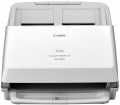Max. scan area
The maximum image size that the scanner can process at one time, both horizontally and vertically. You should pay attention to this parameter if you need the exact dimensions of the scanner's working area, down to a millimetre: although standard formats are used to designate these dimensions (see "Format"), in fact the dimensions may differ from them.
Colour depth (int.)
Under the internal colour depth is meant the number of shades of the image that the scanner itself can recognize; it should not be confused with external depth, which is the amount of hue transmitted to the computer (see below). Colour depth is expressed as the number of bits of information used to encode data about each colour. The total number of colour shades in this case is 2 to the power of n, where n is the colour depth. So, a 24-bit scanner recognizes 16.7 million colours — which is more than one and a half times more than the human eye, and quite enough for simple everyday tasks. In more advanced professional models, colour depth can reach 96 bits. Although the characteristics of the image transmitted to the computer are described by the external colour depth (which can be less than the internal colour depth), the internal depth, however, also affects its quality: other things being equal, a scanner with a higher internal depth provides more accurate colour reproduction.
Colour depth (ext.)
External colour depth characterizes the maximum possible number of colour shades in the image transmitted by the scanner to the computer. A depth of 24 bits is considered quite enough for non-professional tasks, in more advanced models this parameter can reach 96 bits. For details on colour depths and their relationship, see "Colour Depth (Int.)"
Mono scanning
The black and white scanning speed provided by the device. Usually, the maximum processing speed for an A4 sheet is indicated, i.e. speed at the lowest resolution. In fact, the speed is usually lower and depends on both the resolution and the size of the original material. The higher the scanning speed, the more convenient it is to work with the scanner; pay special attention to this parameter if you plan to work with numerous black and white images.
Colour scanning
Colour scanning speed provided by the device. In fact, it depends on the selected resolution, colour depth and original dimensions; the characteristics most often indicate the speed for an A4 sheet at the minimum resolution and colour depth, i.e. maximum possible speed. If you only need to scan one or more sheets from time to time, high speed is not too critical, but for working with a large amount of materials, you should look for fast models.
Operating cycle
The maximum number of pages that the scanner can process per day without overloading and the negative consequences associated with them. Most often indicated for A4 format. Even the most modest models of modern scanners have duty cycles measured in dozens of pages, which is quite enough for simple everyday tasks. Therefore, you should pay attention to this parameter if you have to scan numerous materials every day.
Document autofeed
The maximum number of sheets of standard weight (80 g/m²) paper that can be placed in the scanner's auto feed system at a time. These systems are similar to those installed in printers: a stack of sheets is installed in a special tray, and each of them is fed in turn for scanning. It is worth paying attention to models with this function if you often have to work with numerous documents: you will not need to monitor the process and manually feed sheets — just load the originals into the automatic document feeder and press the button. Many document feeders, some flatbeds, and almost all combination scanners have an ADF (see "Type"). It works, however, only with separate sheets and cannot cope with larger media.
Duplex scanning
Availability of
duplex scanning function in the device. Duplex scanning in this case means such an operating mode in which the scanner simultaneously captures an image from both sides of the processed medium (sheet of paper). The convenience of this feature is obvious: the media does not have to be turned over to scan each side separately, and the processing time is significantly reduced. Double-sided scanning is found mainly in the models of traction or combined type (see above), however, there are also flatbed scanners with this capability.
LCD screen
The scanner has its own
display. Such displays can vary from simple indicators that display a minimum of service information (selected mode, work process, some errors, etc.) to full-colour touch screens that significantly expand the capabilities of the device. Anyway, the display makes the operation of the scanner more convenient and intuitive.

